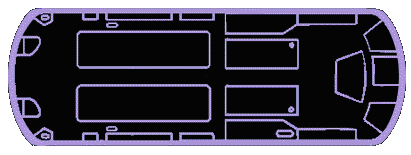Class I Sensor Probe


| Range | 200.000 km |
| Delta-v limit | 0,5c |
| Powerplant | Vectored deuterium micro-fusion propulsion |
| Sensors | Full EM/Subspace and interstellar chemistry pallet for in-space applications |
| Telemetry | 12.500 channels at 12 megawatts |

| Range | 400.000 km |
| Delta-v limit | 0,65c |
| Powerplant | Vectored deuterium micro-fusion propulsion, with extended deuterium fuel supply |
| Sensors | Same instrumentation as a Class I Probe, with addition of enhanced
long-range
particle and field detectors and imaging system |
| Telemetry | 15.650 channels at 20 megawatts |

| Range | 1.200.000 km |
| Delta-v limit | 0,65c |
| Powerplant | Vectored deuterium micro-fusion propulsion |
| Sensors | Terrestrial and gas giant sensor pallet with material smaple and return
capability,
and an on-board chemical analysis sub-module |
| Telemetry | 13.250 channels at approximately 15 megawatts |
| Additional,Data | Limited SIF hull reinforcement. Full range of terrestrial soft landing
to subsurface
penetrator missions. Gas giant atmosphere missions survivable to 450 bar pressure. Limited terrestrial loiter time |

| Range | 3.500.000 km |
| Delta-v limit | 0,60c |
| Powerplant | Vectored deuterium micro-fusion propulsion supplemented with continuum
driver coil,
and an extended maneuvering deuterium supply |
| Sensors | Triply redundant stellar fields and particles detectors, stellar atmosphere analysis suite |
| Telemetry | 9.780 channels at 65 megawatts |
| Additional,Data | Six ejectable and survivable radiation flux subprobes.
Deployable for non-stellar energy phenomena |

| Range | 43.000.000.000 km |
| Delta-v limit | Warp 2 |
| Powerplant | Dual-mode matter / antimatter engine. Extended duration at sub-light,
and limited duration at warp |
| Sensors | Extended passive data-gathering and recording systems, with full
autonomous mission execution and return system |
| Telemetry | 6.320 channels at 2,5 megawatts |
| Additional,Data | Planetary atmosphere entry and soft landing capability.
Low observability coatings and hull materials. Can be modified for tactical applications with addition of custom sensor countermeasure package |

| Range | 43.000.000.000 km |
| Delta-v limit | 0,8c |
| Powerplant | Microfusion engine with high output MHD power tap |
| Sensors | Standard pallet |
| Telemetry | 9.270 channel RF and subspace transceiver operation at 350 megawatts peak radiated power. 360 omni antenna coverage, 0,0001 arc-second high-gain antenna pointing resolution |
| Additional,Data | Extended deuterium supply for transceiver power generation and planetary orbit plane changes |

| Range | 450.000.000 km |
| Delta-v limit | Warp 1,5 |
| Powerplant | Dual-mode matter / antimatter engine |
| Sensors | Passive data gathering system plus subspace transceiver |
| Telemetry | 1.050 channels at 0,5 megawatts |
| Additional,Data | Applicable to civilizations up to technology level III.
Low observability coatings and hull materials. Maximum loiter time: 3,5 months. Low-impact molecular destruct package tied to anti-tamper detectors |

| Range | 120 light years |
| Delta-v limit | Warp 9 |
| Powerplant | Matter / antimatter warp field sustainer engine. Duration 6,5 hours
at warp 9.
MHD power supply tap for sensors and subspace transceiver |
| Sensors | Standard pallet plus mission-specific modules |
| Telemetry | 4.550 channels at 300 megawatts |
| Additional,Data | Applications vary from galactic particles and fields research to
early-warning reconnaissance missions |

| Range | 760 light years |
| Delta-v limit | Warp 9 |
| Powerplant | Matter / antimatter warp field sustainer engine. Duration 12 hours at warp 9. Extended fuel supply for Warp 8 maximum flight duration of fourteen days |
| Sensors | Standard pallet plus mission-specific modules |
| Telemetry | 6.500 channels at 230 megawatts |
| Additional Data | Limited payload capacity. Isolinear memory storage of 3.400 kiloquads. Fifty-channel transponder echo. Typical application is emergency log-message capsule on homing trajectory to nearest starbase or known Starfleet vessel position |